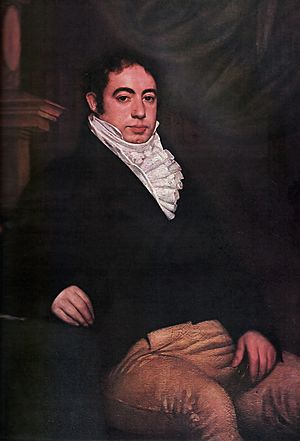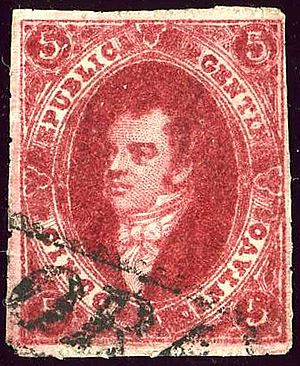Bernardino Rivadavia facts for kids
Quick facts for kids
Bernardino Rivadavia
|
|
|---|---|
 |
|
| 1st President of Argentina | |
| In office February 8, 1826 – June 27, 1827 |
|
| Preceded by | Juan Gregorio de Las Heras (Governor of Buenos Aires) |
| Succeeded by | Vicente López |
| Personal details | |
| Born | May 20, 1780 Buenos Aires, Viceroyalty of the Río de la Plata |
| Died | September 2, 1845 (aged 65) Cádiz, Spain |
| Nationality | Argentine |
| Political party | Unitarian Party |
| Spouse | Juana del Pino y Vera Mujica |
| Children | José Joaquín (1810-1887), Constancia (1812-1816), Bernardino Donato (1814-1881) and Martín (1823-1885) |
| Profession | Lawyer |
Bernardino de la Trinidad González Rivadavia (born May 20, 1780 – died September 2, 1845) was the first President of Argentina. At that time, Argentina was known as the United Provinces of Rio de la Plata. He served as president from February 8, 1826, to June 27, 1827.
Bernardino Rivadavia went to the Royal College of San Carlos but did not finish his studies. He helped defend the country during the British Invasions in 1806. He also took part in a special meeting on May 22, 1810, where people voted to remove the Spanish ruler.
Later, he became an important person in the First Triumvirate, which was a group of three leaders. Soon after, he worked as the Minister of Government and Foreign Affairs for the Province of Buenos Aires.
Even though a General Congress was planning to write a constitution, a war with Brazil began. This led to the quick creation of the President of Argentina role, and Rivadavia was the first to be chosen. Argentina's Constitution of 1826 was introduced later, but many provinces did not accept it. Because of strong disagreements from his political party, Rivadavia resigned. Vicente López y Planes took over as president after him.
Rivadavia moved to Spain, where he passed away in 1845. His body was brought back to Argentina in 1857, and he was honored as a Captain General. Today, his remains are in a special tomb in Plaza Miserere, next to Rivadavia Avenue, which is named after him.
Biography
Early life
Bernardino Rivadavia was born in Buenos Aires on May 20, 1780. He was the fourth son of Benito Bernardino González de Rivadavia, a rich lawyer from Spain, and his first wife, María Josefa de Jesús Rodríguez de Rivadeneyra. On December 14, 1809, he married Juana del Pino y Vera Mujica. She was the daughter of Joaquín del Pino, who was the Spanish ruler of the Río de la Plata.
Career
Rivadavia was active in Argentina's fight against the British invasion in 1806. He also played a role in the May Revolution in 1810, which led to Argentina's independence. In 1811, Rivadavia became a very important member of the government's triumvirate, serving as Secretary of the Treasury and Secretary of War. This government worked to create a strong central government, improve relations with Spain, and build an army.
By 1814, the Spanish King Ferdinand VII was back on the throne. He wanted to bring back absolute rule, which caused problems for governments in the Americas. Manuel Belgrano and Rivadavia were sent to Europe to ask for support for the United Provinces from Spain and Britain. They tried to get Francisco de Paula, the son of Charles IV of Spain, to become a ruler for the United Provinces. However, he refused to act against the King of Spain's wishes. This trip to Europe was not successful. Rivadavia also visited France and returned to Buenos Aires in 1821 when his friends asked him to.
While in Britain, Rivadavia saw the big changes happening with the Industrial Revolution. He also saw the rise of Romanticism, a new style of art and ideas. He wanted to bring similar progress to Buenos Aires and invited many people to move there. He convinced Aimé Bonpland, a famous scientist, to visit the country.
In June 1821, the governor Martín Rodríguez made Rivadavia the minister of government for Buenos Aires. For the next five years, Rivadavia had a lot of power. He focused heavily on making the city of Buenos Aires better, sometimes without thinking as much about the rest of Argentina. To make Buenos Aires look more like a European city, Rivadavia built wide streets, schools, and added paved and lighted roads. He started the University of Buenos Aires, as well as academies for Theatre, Geology, and Medicine. He also founded the continent's first museum of natural science.
He convinced the government to approve a large loan of one million pounds for public works. However, these projects were never completed. The money was borrowed from the Baring Brothers Bank in London. The borrowed money was then lent to local businessmen, who never paid it back. Out of the original million pounds, the Buenos Aires government only received £552,700. The province's foreign debt was transferred to the nation in 1825 and was finally paid off in 1904.
Rivadavia strongly believed in a powerful, central government for Argentina. This often led to strong opposition from federalists, who wanted more power for the provinces. In 1826, Rivadavia was elected the first President of Argentina. During his time as president, he started many museums and made the national library bigger.
Presidency
His government faced many challenges. There was an ongoing war with Brazil over land in what is now Uruguay. He also faced resistance from leaders in the provinces. With the growing power of the Federalist Party and several provinces openly rebelling, Rivadavia resigned on June 27, 1827. Vicente López y Planes took his place. At first, Rivadavia went back to private life, but he had to leave for Europe in 1829.
Rivadavia returned to Argentina in 1834 to face his political opponents. However, he was immediately sent into exile again. He went first to Brazil and then to Spain, where he died on September 2, 1845. He asked that his body never be brought back to Buenos Aires.
Legacy
Bernardino Rivadavia is known as the first president of Argentina. However, his rule was mainly accepted only in Buenos Aires. He did not complete a full term, and there was no constitution for more than half of his time in office. Also, he did not start a clear line of presidents. The chair of the President of Argentina is sometimes called the "chair of Rivadavia." This is a symbolic name because Rivadavia took everything, including the actual chair, when he left office, and it was never found again.
Some historians praise Rivadavia as a great leader. They highlight his efforts to improve education, culture, and the idea of keeping the church and government separate. Other historians criticize him for favoring British interests. They point out that his policies allowed many British goods to enter Argentina, which hurt the country's own growing economy. They also criticize the Baring Brothers loan, which started Argentina's foreign debt.
See also
 In Spanish: Bernardino Rivadavia para niños
In Spanish: Bernardino Rivadavia para niños
Images for kids




